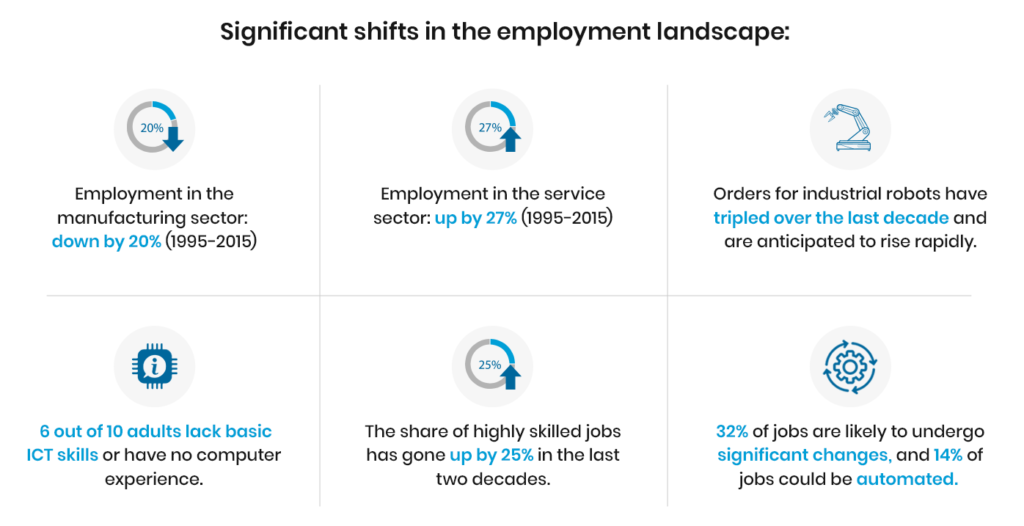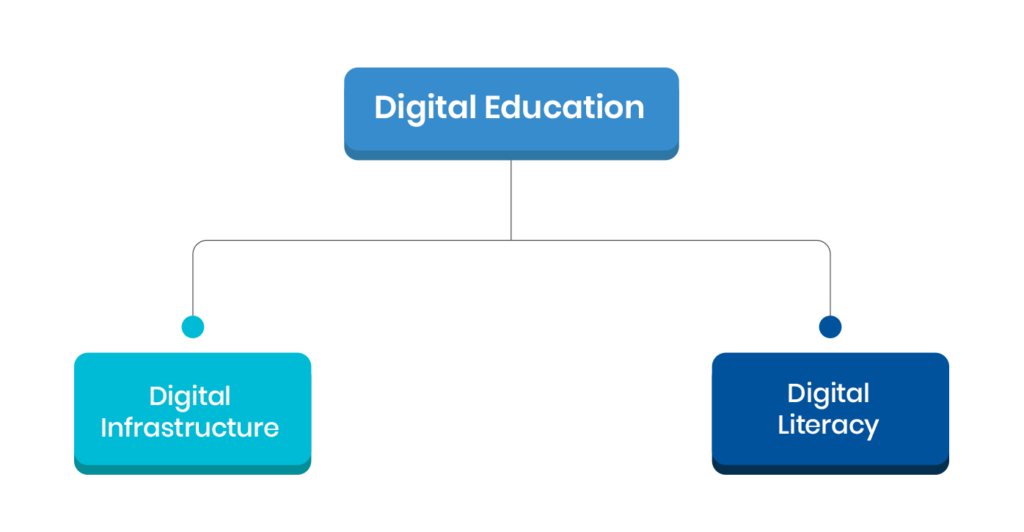Preparing Students for the Future: The Importance of Education 4.0
Countless forecasts have been made regarding the future of work. Leading organizations from all over the world have been warning of impending changes in the way the working world is structured for years.
The impact and opportunities of the internet have been evident for more than a decade. A thorough analysis by McKinsey in 2011 revealed that while the Internet has eliminated 500,000 jobs over the past 15 years, it has also generated 1.2 million new ones, totaling a net increase of 700,000 or 2.4 jobs for each job that was eliminated. This implies that digitalization and connectivity offers a field of opportunities, just waiting to be plucked.

This shows that there has been a clear shift in the priority of skill sets in the 21st-century employment landscape. Digital literacy and fundamental ICT skills are becoming increasingly essential now more than ever.
In 2019, The Future of Work report by OECD recognized three factors that has a significant impact on the job market- Globalization, technological advancement, and demographic shift.
The Education 4.0 initiative was launched by the World Economic Forum and UNICEF in 2020 to increase access to digital learning, eradicate the disparities in the Indian education system, and foster a holistic learning environment for the youth of India.
Want to explore the 5 foundational pillars of Education 4.0? Click here.
Skill development for the evolving 21st-century job landscape received widespread attention in the Education 4.0 initiative.
Transforming the Education Landscape to Align with Industry 4.0

Nearly all occupations are changing to reflect the expanding use of technology and the automation of repetitive tasks, along with the emergence of new fields. In order to maintain a competitive advantage and develop students for digitally advanced industries, education institutions should prioritize the following:
- Development of digital infrastructure to facilitate blended learning strategies.
- Development of digital literacy for a comfortable “school-to-work” transition.
A clear advantage over machines in modern workplaces will continue to exist for companies with robust digital infrastructure and employees with well-trained digital literacy. Hence, in addition to receiving a foundational education in ICT, students should be immersed from the start in a cutting-edge digital ecosystem.
Digital Infrastructure:
The digital infrastructure of a university can be defined as the equipment, tools, and technological innovations implemented and used to establish itself in the online world. A robust digital infrastructure allows institutions to completely transform their existing brick-and-mortar setup and maximize efficiency in the long run.
For instance, digital edtech platforms, internet connectivity, devices like smartboards, etc.
Some of the unmatched benefits of a well-established digital infrastructure:
- Educators and students can stay connected at all times via the internet.
- Limitless digital course content repositories accessed online and on demand.
- Blended learning environment for continuous practice and maximum knowledge retention.
- Effective assessment and evaluation through online assignments.
- Automation of mundane and repetitive tasks for ease of management.
- Immediate feedback to guide and eliminate knowledge gaps in real-time.
- Precise analytics and insights into learning patterns and student behavior.
- Multimedia content for the comprehension of intangible concepts like quantum physics, chemical bonds, astronomy, etc.
Digital Literacy:
Digital infrastructure is worthless without digital literacy.
Institutions, colleges, and universities are open to the idea of creating a blended learning environment, which is unachievable without digital tools and cloud-based technologies. Students in this digital era need to get familiar with digital dashboards, automation, multimedia content, and other immersive technologies that are already prevalent in many industries.
Universities continue to play a crucial role in ensuring that the youth is prepared to be active citizens and productive workers in light of the growing “job disruption” and “increased socioeconomic polarization.”
To prepare students for the digitally advanced workspaces of the twenty-first century, existing curricula need to be redesigned. Lessons should be taught through interactive methods via digital platforms that foster the critical and individual thinking required in the innovation-driven future.
Creative problem-solving, collaboration, and self-management need to be explicitly taught via blended learning pedagogies alongside academic knowledge and deeply ingrained into the curriculum.
The Ultimate Goal
In a perfect world, educational models would integrate digital learning pedagogies, enabling the students to gain the skills and abilities they need to succeed, ultimately resulting in a more “inclusive, interconnected, and productive world.”
As discussed above, the students of this technologically advanced era need to be immersed in digital learning to develop specific skills for the 21st-century workspace. Universities with robust digital infrastructure and opportunities for digital literacy will unlock innovative blended learning strategies and facilitate a seamless transition to the working world, ultimately producing successful innovators of tomorrow.
Modernizing STEM Education with Möbius
DigitalEd India offers an interactive Möbius platform that enables students to work in an increasingly digital world. It helps create a cohesive digital learning ecosystem for STEM students.
Here’s how Möbius aligns STEM education with industry 4.0:
- An immersive digital learning environment to prepare students for modern workspace;
- It facilitates a blended learning approach with a seamless and easy-to-use digital dashboard;
- Educators can design, develop and distribute interactive digital courses across the globe;
- Educators can stay connected with the students digitally throughout the learning process;
- Educators can add multimedia content and inline questions to reinforce knowledge in-between lessons.
Want to learn more?
Contact us to book an in-depth demo session with our product expert.
Stay tuned for more additions to the Education 4.0 series.